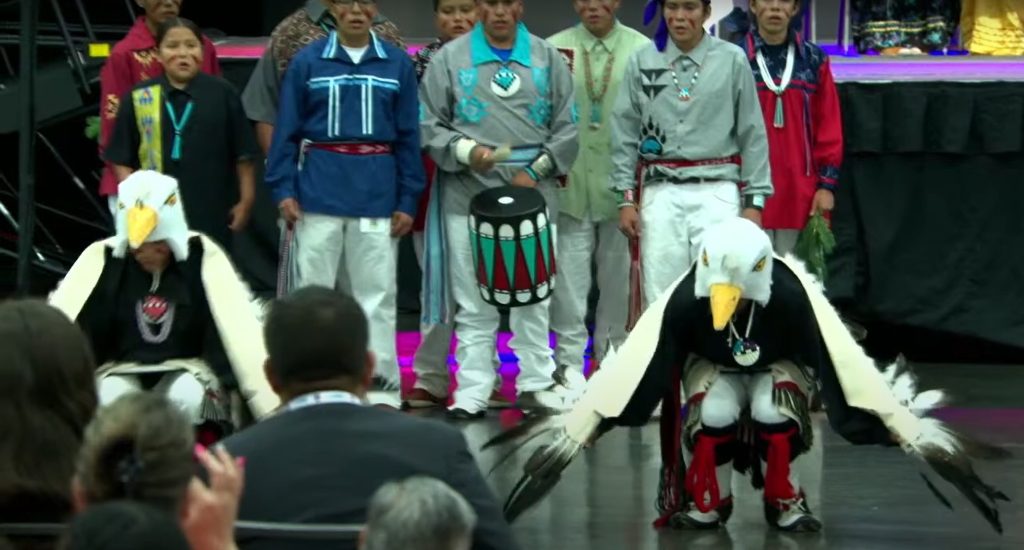Podcast: Play in new window | Download | Embed
Native young people from across the country are gathered in Portland, Ore. this week.
They’re enhancing their leadership skills at the United National Indian Tribal Youth (UNITY), Inc. Conference, as Rhonda LeValdo reports.
This year’s UNITY Conference theme is “Revitalizing Our Roots”, which focuses on increasing access to cultural protective factors and traditional tools to improve the mental health of Native youth nationwide.

UNITY attendee Mateni Hutchins. (Photo: Rhonda LeValdo)
First time attendee Mateni Hutchins from the Confederated Tribes of Umatilla Indian Reservation says it’s been a great experience.
“Leadership wise, it’s good to have communications with all the people to know like what needs to be done, what does not need to be done, and what’s already finished. And that, other than that you can like communicate, like try to help others when they need it, and when they don’t.”

UNITY attendee Miss Indian Northwest Leilonnie Wilson. (Photo: Rhonda LeValdo)
Many tribal royalty are in attendance.
Miss Indian Northwest Leilonnie Wilson says it helps with her leadership skills.
“For two years, I was our female co-president and so I had to get up and talk about, you know, what we have done, you know, what we are accomplished or what we want to accomplish. So you know, being and talking in front of the whole region and it kind of brought me out of my shell, you know. Especially with royalty, that’s another thing, you know takes me out of my shell. It helps with my public speaking skills.”
On Monday, all attendees will take a trip to visit the NIKE world headquarters.
The conference ends on July 3.

Sealaska Heritage Institute Director of Archives and Collections Emily Galgano shows the Chilkat robe. (Photo: Yvonne Krumrey / KTOO)
A Wisconsin museum has sent a Chilkat robe it’s had for the last 80 years to Sealaska Heritage Institute in Juneau, Alaska.
The idea is to identify which clan it belongs to and give it back to them.
KTOO’s Yvonne Krumrey has more.
In the basement of the Walter Soboleff building on a recent afternoon, Emily Galgano opened a huge white cabinet.
She pulled out a long drawer with a Chilkat robe laying inside. The robe’s colors are faded.
“So it could be very old, or it could be less old. I’m assuming at least 100, 150 years old. But it’s hard to say exactly.”
In May, a Wisconsin museum sent a Chilkat robe that it’s had for the last 80 years to Sealaska Heritage Institute in Juneau to identify which clan it belongs to and, hopefully, give it back to them.
Galgano is Sealaska Hertiage Institute’s archives and collections director.
She said the robe is a diving whale design.
Some of the black coloring has faded to purple and rust. Other spots are still rich and dark, which could indicate a different batch of dye.
With gloves on, Galgano flipped a corner of the robe to reveal colors much closer to how they might have looked when the robe was new: dark blacks and bright yellows.
Earlier this month, the robe was on display during Celebration.
Galgano had hoped that people might see it and know something about its origins.
“We’re always working with the community to try and crowdsource that sort of information. This is the first time I’ve done something with an object like this, that’s of this scale — but we have done similar, smaller projects.”
The robe is on loan from the Rahr-West Museum in Manitowoc, Wisc.
Greg Vadney, the museum’s executive director, said they don’t have anything else like it — he believes it came to the museum in the 1940s from someone who served in the U.S. Coast Guard in Alaska.
“We have nothing else that we know that even comes from the Pacific Northwest, let alone Alaskan tribal culture. So we were excited to be able to return it to its home. And we’re also very excited that hopefully, while it’s at Sealaska Heritage, some of the gaps in the history that we don’t know about — some of that detail can get filled in in this partnership.”
He said the idea to reach out to SHI came from Manitowoc artist Skip Wallen, who designed the whale sculpture in Juneau’s Overstreet Park.
Vadney said Rahr-West is eager to return the robe to its original owners.
“Certainly as a museum, oftentimes we kind of, unfortunately, look at the things as things, and forget about the material culture of it and the human element. And in this case, the spiritual element that is inherent to it.”
The robe is on loan to SHI for the next year, but it could stay in Juneau long term while the organizations decide next steps.
“Our thought process is, this is a step towards repatriation.”
Galgano said SHI’s next step will be gathering expert weavers to study the robe.
“If it belongs to a clan, and it’s something like at.oo — where it’s a clan-owned object — then we also have a process where clans can long-term loan items here, where we’ll still care for it. It’ll still be in our climate-controlled vault and taken care of here, but it won’t belong to the museum, and they can then check it out for ceremonies, things like ku.eek.”
Galgano said she wants anyone who thinks they may have information about the robe to make an appointment to come see it by emailing her at emily.pastore@sealaska.com.
Get National Native News delivered to your inbox daily and stay up-to-date on the 2024 Native Vote. Sign up for our daily newsletter today.



